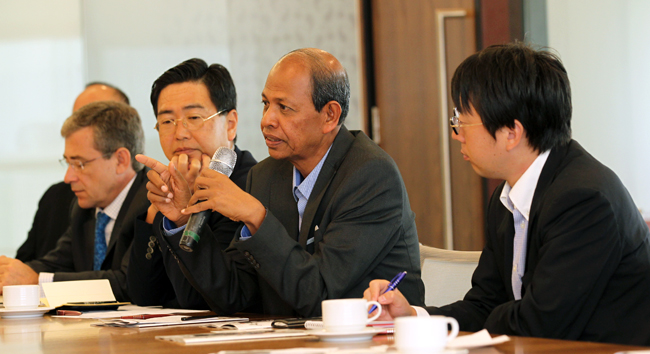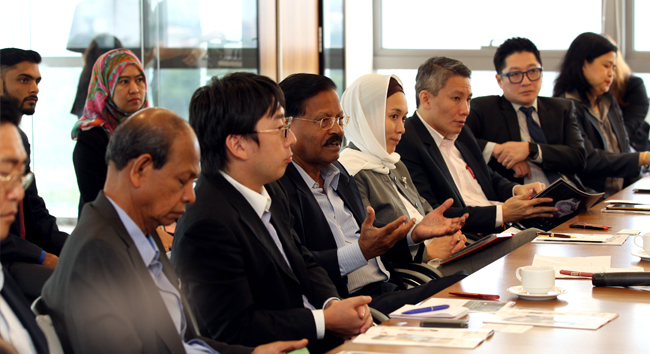ASEAN Roundtable Series: Growth drivers for ASEAN in stagnating global economy
Published on 26 October 2016


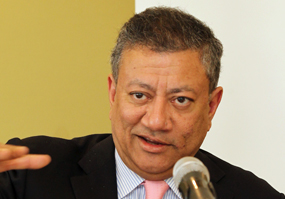
Dr. Arup Raha
Chief Economist, CIMB ASEAN Research Institute
Read more
Arup has a Bachelor of Arts (Honours) degree in Economics from St. Stephen’s College, Delhi, a Masters from the Delhi School of Economics and a Doctor of Philosophy in Economics from Vanderbilt University in the United States.

Dr. Yeah Kim Leng
Member, Bank Negara Monetary Policy Committee Professor, Sunway Business School Former Chief Economist, RAM Holdings
Read more
Prior to joining the academia, he had a 20-year stint at RAM Holding Berhad (RAM), the country’s first credit rating agency, principally as the chief economist and managing director of its wholly-owned consulting subsidiary. Prior to RAM, he was a Senior Analyst at the Institute of Strategic and International Studies (ISIS) Malaysia. He holds an MBA and PhD in Agricultural and Resource Economics from the University of Hawaii and a Bachelor of Science degree in forestry from Universiti Pertanian Malaysia.
He is a Vice-President of the Malaysian Economic Association and a trustee of the Malaysian Tax Research Foundation. He is also one of the two external members appointed to Bank Negara Malaysia’s Monetary Policy Committee in 2015.
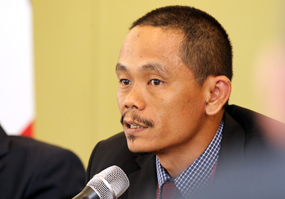
Mr. Nurhisham Hussein
Head, Economics and Capital Markets Department, Employees Provident Fund Malaysia
Read more
Nurhisham began his career in merchant banking in the 1990s, before joining Perwira Affin Bank in 1997 as part of the Corporate Planning Department. He later joined Permodalan Nasional Berhad (PNB) in 2004 to head the Economics section of the Research Division. There he was responsible for monitoring, analysis and reporting of economic conditions, providing input for PNB’s investment decisions. He joined EPF after a stint with the Malaysian Rating Corporation Berhad (MARC), producing country reports, developing economic viewpoints and making quantitative forecasts.
He holds a Bachelors of Science (Econs) in Monetary Economics from the University of London School of Economics and Political Science (LSE), and a Masters in Economics from University Malaya (UM).

Dr. Rafael Muñoz Moreno
Senior Country Economist, Malaysia, World Bank
Read more
Mr. Muñoz joined the World Bank in 2005 as part of the Young Professional Program. He has worked in the office of the Vice President of the Economic Department and has served as Country Economist in the Africa region. Prior to moving to Malaysia, he was in Mauritius as Country Economist and Resident Representative, coordinating the World Bank work program with Mauritius and Seychelles.
Previously, Mr. Muñoz worked in the Spanish Embassy in Tokyo as Economist and in the European Commission as Operation Officer in charge of budget support projects in Latin America.
Mr. Muñoz holds a PhD in Economics from the University of Louvain (Belgium) and a European Doctoral Program in Quantitative Economic after attending the London School of Economics. He has published several research papers, mostly on macroeconomic policies, labor economics and business cycles.

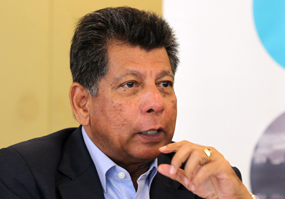
Tan Sri Dr. Munir Majid
Chairman, CIMB ASEAN Research Institute President, ASEAN Business Club
Read more
On his return to Malaysia at the end of 1978, Tan Sri Dr. Munir joined The New Straits Times Press (NSTP) as a lead writer and progressed to become its Group Editor. He left The NST in 1986 to become the CEO of a small merchant bank, Pertanian Baring Sanwa (PBS), which then became Commerce International Merchant Bankers, the genesis of today’s CIMB Group. He left CIMB in 1993 at the invitation of the Government of Malaysia to set up the Securities Commission and became its first Executive Chairman until 1999. He continued with his illustrious career, serving in various capacities, including as Chairman of both Celcom and Malaysia Airlines System at different times. He was the founder and President of the Kuala Lumpur Business Club (2003-2008), and was the chairman of its Advisory Council. Dr. Munir, an Honorary Fellow, is Visiting Senior Fellow at LSE IDEAS (Centre for international affairs, diplomacy and strategy).

The roundtable discussed the growth prospects for Asean economies in the face of a global stagnating economy. “China’s rebalancing to consumer led growth and a maturing supply chain reduces the demand for Asean imports. Europe and Japan are not doing particularly well, therefore the only delta for global growth will be from the US,” said Dr. Arup Raha, CARI Chief Economist. In this regard, he commented that Asean cannot hope for an export led growth recovery – a view which was echoed across all the speakers. With little hope on the external front, Asean economies will need to turn to ammunition on the domestic front. What policies can be pursued to spur growth in the 3-5 year horizon? Consumer demand has held up thanks to low energy prices and low inflation, however, the space for monetary policy is tightening. Dr. Arup posed questions on the scope for fiscal policy and addressing inequality which has proved to be a drag on growth prospects.


Dr. Yeah Kim Leng, Professor at Sunway University suggested improving labour force participation, particularly female participation and labour productivity to unlock growth opportunities. Mr. Nurhisham Hussein, the Head of Economics at the Employees Provident Fund (EPF) of Malaysia, concurred and added, “In addition to what we do, it is important to also improve how we do things – corporate governance, efficiency and management training can greatly improve labour productivity,” he noted. However, Dr. Rafael Moreno, Malaysia Country Economist at the World Bank commented that in areas such as exports, productivity levels are already at very competitive levels and thus gains from further improvement in productivity would be moderate. However, improving productivity in inefficient sectors such as the services sector will provide better returns. Dr. Arup added that areas such as bankruptcy and competition law reforms can also provide an avenue to encourage innovation and productivity.
“The world is entering a post-industrial era, we don’t need a lot of labour to make things anymore. We won’t see the export growth model that we used to have, the low cost labour strategy will not be beneficial in the future,” said Nurhisham. He added that the case for increasing labour productivity is urgent given Asean demographics which while young, is aging rapidly – estimated at 3-4 times faster than the U.S. and Japan, thus we only have one generation to get the growth strategy right.

There was consensus that fiscal policy has its role to play and can be an effective tool. Dr. Rafael noted however that countries must be careful not to use fiscal policy to avoid difficult reforms and in fact, taking the opportunity to couple fiscal policy with structural reforms can be an effective and powerful tool. He added that most Asean economies do not have automatic fiscal stabilisers such as unemployment benefits and in some countries, the social help system is very fragmented. Thus, targeting the social help system can be an area of policy reform to accompany fiscal spending. Nurhisham also added that fiscal policy can, for example, develop the R&D sector which is currently very low in Asean. However, he mentioned taking fiscal policy too far can be dangerous for countries that are experiencing a peak in its population.

The Asean region has a cumulative current account surplus (excess of savings over investment) of about RM80 billion. Dr. Yeah commented that greater mobilization of such capital across the region through front loading of infrastructure development can provide some source of growth opportunities. In addition, firms can take advantage of the multiplier effect from urbanization growth and the infrastructure demands from expanding cities. Nurhisham and Dr. Rafael agreed but provided the view that while desirable, non-tariff-barriers which exist across the region will reduce incentives for firms to do so. The speakers noted that non-tariff barriers is not an Asean specific issue and were concerned that globally, there has been a general increase in non-tariff-barriers partly due to the increasing protectionist and de-globalization sentiment. Nevertheless, there was agreement that greater Asean integration, for example easing barriers to cross border trade, will be beneficial to growth. Dr. Munir added that while ideal, in practice formulating integration policies and implementation at the Asean level can be a lengthy process, thus a more functional approach (i.e. Asean-X formula) to integration can be an effective alternative. Dr. Arup agreed with the opportunities from integration but emphasized the need to think of homegrown remedies which are within each country’s control to implement in the near term.

“Broadening and deepening of the financial sector can kill two birds as a complementary strategy for inequality and growth. Further development in the bond and capital markets can boost the long term savings rate and also provide financing avenues for long term infrastructure projects” said Dr. Yeah. Tan Sri Dr. Munir added that in addition to financial deepening, financial integration can also spur growth in areas such as the digital economy. He mentioned the difficulties in standardizing payment gateways across the region as inhibitive to e-commerce growth which has much potential in the region.

The roundtable concluded that the world is entering a global growth era unlike we’ve seen before. There needs to be acceptance that the growth rates experienced in the past will not be sustained in the future. The “new normal” will be a moderated growth environment. Targeted fiscal policy and improved productivity measures can serve as domestic remedies in the medium term while structural reforms will need to be put in place for long term economic competitiveness. Asean integration can be the biggest chance to compensate for a slowing global economy, although removal of non-tariff barriers will be needed to unlock Asean’s true potential.

